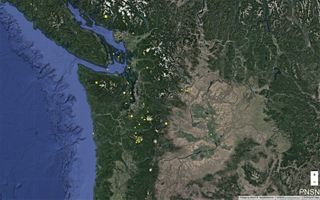The Next Cascadian Megaquake May Be Sooner Than You Think

Devastating Cascadia megaquakes may rock the Pacific Northwest more frequently than previously suspected.
A new effort to systematically analyze geologic evidence, such as rocks and soil dumped into the ocean by ancient and powerful quakes, hints that the time between massive earthquakes may be up to 200 years shorter than previously thought, according to research presented on May 16 at the annual meeting of the Seismological Society of America (SSA), in Miami.
The higher frequency of megaquakes could spell trouble for infrastructure in the region, which may not be adequately prepared to withstand their power.
"Adding these earthquakes into our recurrence calculations could change our estimates of likely ground shaking by about 40 percent," Joan Gomberg, a seismologist with the U.S. Geological Survey (USGS), said in a statement. [The 10 Biggest Earthquakes in History]
Giant fault line
Along North America's Pacific Northwest coast lies the Cascadia fault, also known as the Cascadia subduction zone (CSZ). The CSZ extends for nearly 700 miles (1,100 kilometers) from Canada's Vancouver Island to Northern California in the U.S.
In the CSZ, pressure builds up from the incremental movement of the Juan de Fuca plate as it dives beneath the North American plate. Centuries pass before the plates finally build up enough pressure to slip past each other, and the sudden, cataclysmic release triggers what is known as a "megathrust" earthquake, according to the Pacific Northwest Seismic Network. At magnitudes of 8.5 or more, these are the most powerful temblors on Earth.
The geologic record suggests that the fault has produced catastrophic quakes of magnitude 8.0 to 9.0, along with destructive tsunamis, at least every 500 years or so. The last major quake rumbled up the coast in 1700, with an estimated magnitude of 8.7 to 9.2.
Sign up for the Live Science daily newsletter now
Get the world’s most fascinating discoveries delivered straight to your inbox.
However, big quakes along the southern part of the fault could strike more frequently, appearing every 300 years, the new research suggests.
To understand these massive quakes and how frequently they emerge, the scientists with the Cascadia Recurrence Project Team (CRPT) are investigating traces left behind by megaquakes that happened centuries ago: evidence of past earthquake-triggered landslides, as well as changes in coastal land levels and ocean sediment deposits from quakes and tsunamis. The researchers also looked at computer models of fault ruptures and ran simulations of ground shaking during quake events, according to the presentation.
Despite having lots of evidence from past quakes, "interpretation of our observations don't always agree," Gomberg said.
By analyzing many avenues of evidence together, CRPT scientists are hoping to identify where the divergence in recurrence estimates originated and to reconcile those disagreements, Gomberg said.
Clues from some areas in the Cascadian fault points to a 500-year interval between megathrust earthquakes. However, formations on the sea bottom called turbidites — deposits of rocks and soil dumped in large quantities into the ocean all at once — from the southern part of the CSZ tell another story, hinting at an interval closer to 300 years, the researchers reported at the conference.
The team still hasn't yet resolved the CSZ megaquake timetable, but the prospect of more-frequent megathrust quakes along the southern region of the fault could mean problems for the area, Gomberg said. Specifically, existing building safety codes, which are developed alongside earthquake hazard assessments, may not make structures strong enough to withstand a likely megaquake, Gomberg said.
Original article on Live Science.

Mindy Weisberger is an editor at Scholastic and a former Live Science channel editor and senior writer. She has reported on general science, covering climate change, paleontology, biology, and space. Mindy studied film at Columbia University; prior to Live Science she produced, wrote and directed media for the American Museum of Natural History in New York City. Her videos about dinosaurs, astrophysics, biodiversity and evolution appear in museums and science centers worldwide, earning awards such as the CINE Golden Eagle and the Communicator Award of Excellence. Her writing has also appeared in Scientific American, The Washington Post and How It Works Magazine.
